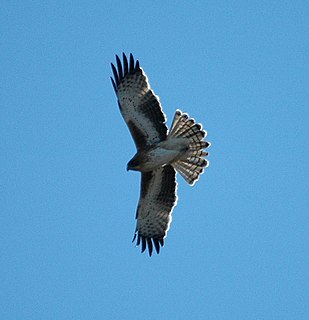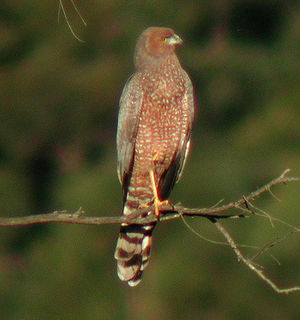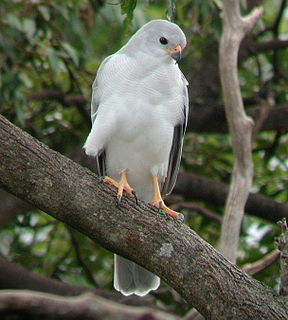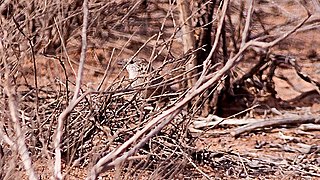
The white-bellied sea eagle, also known as the white-breasted sea eagle, is a large diurnal bird of prey in the family Accipitridae. Originally described by Johann Friedrich Gmelin in 1788, it is closely related to Sanford's sea eagle of the Solomon Islands, and the two are considered a superspecies. A distinctive bird, the adult white-bellied sea eagle has a white head, breast, under-wing coverts and tail. The upper parts are grey and the black under-wing flight feathers contrast with the white coverts. The tail is short and wedge-shaped as in all Haliaeetus species. Like many raptors, the female is slightly larger than the male, and can measure up to 90 cm (35 in) long with a wingspan of up to 2.2 m (7.2 ft), and weigh 4.5 kg (9.9 lb). Immature birds have brown plumage, which is gradually replaced by white until the age of five or six years. The call is a loud goose-like honking.

Major Mitchell's cockatoo, also known as Leadbeater's cockatoo or the pink cockatoo, is a medium-sized cockatoo restricted to arid and semi-arid inland areas of Australia. It is here placed in its own monotypic genus Lophochroa, though to include it in Cacatua as others do is not wrong as long as the corellas are also included there. They are also a type of cockatoo.

The Royal Australasian Ornithologists Union (RAOU), now part of BirdLife Australia, was Australia's largest non-government, non-profit, bird conservation organisation. It was founded in 1901 to promote the study and conservation of the native bird species of Australia and adjacent regions, making it Australia's oldest national birding association. In 1996, the organisation adopted the trading name of Birds Australia for most public purposes, while retaining its original name for legal purposes and as the publisher of its journal, the Emu. In 2012, the RAOU merged with Bird Observation & Conservation Australia to form BirdLife Australia.

The Australian brushturkey or Australian brush-turkey or gweela, also frequently called the scrub turkey or bush turkey, is a common, widespread species of mound-building bird from the family Megapodiidae found in eastern Australia from Far North Queensland to Eurobodalla on the south coast of New South Wales. The Australian brushturkey has also been introduced to Kangaroo Island in South Australia. It is the largest extant representative of the family Megapodiidae, and is one of three species to inhabit Australia.

The barking owl, also known as the winking owl, is a nocturnal bird species native to mainland Australia and parts of Papua New Guinea and the Moluccas. They are a medium-sized brown owl and have a characteristic voice with calls ranging from a barking dog noise to a shrill human-like howl of great intensity.
The Australian Bird Count (ABC) was a project of the Royal Australasian Ornithologists Union (RAOU). Following the first and successful Atlas of Australian Birds project, which led to the publication of a book on the distribution of Australian birds in 1984, it was suggested by Ken Rogers that the RAOU should next look at bird migration and other movements in Australia. Methodology for a suitable project involving volunteers was worked out through experimental fieldwork and a workshop on ‘Monitoring the Populations and Movements of Australian Birds’.

The Australian bustard is a large ground dwelling bird which is common at grassland, woodland and open agricultural country across northern Australia and southern New Guinea. This bustard stands at about one metre high, the wingspan is around twice this length. The species is nomadic, flying to areas when food becomes plentiful, and capable of travelling long distances. They were once widespread and common to open plains of Australia, becoming rare in regions that became populated during the colonisation of Australia. The diet of Ardeotis australis is omnivorous, they mostly consume the fruit or seed of plants, but include invertebrates such crickets or grasshoppers and smaller mammals, birds or reptiles. The species is also commonly referred to as the plains turkey, and in Central Australia as bush turkey, particularly by Aboriginal people who hunt it, although this name may also be used for the Australian brushturkey as well as the orange-footed scrubfowl.

The little eagle is a very small eagle native to Australia, measuring 45–55 cm in length and weighing 815 g (1.8 lb), roughly the size of a peregrine falcon. It tends to inhabit open woodland, grassland and arid regions, shunning dense forest. It is a near relative of both the Palearctic booted eagle and the massive but now extinct Haast's eagle of New Zealand.

Dr Penelope Diane Olsen is an Australian ornithologist and author. She has worked with CSIRO as an experimental officer and an Honorary Research Associate as well as being an ARC Postdoctoral Fellow at the Australian National University. She is also internationally recognised as an expert on raptors and was involved in the conservation work on Norfolk Island for the Norfolk Island Boobook. She was President of the Australasian Raptor Association 1984–1989. In 1997 she was awarded the Royal Australasian Ornithologists Union's D.L. Serventy Medal for excellence in published work on birds in the Australasian region.

The spotted harrier also known as the smoke hawk, is a large Australasian bird of prey belonging to the family Accipitridae.

The grey goshawk the white morph of which is known as the white goshawk, is a strongly built, medium-sized bird of prey in the family Accipitridae.

The grey falcon is a medium-sized falcon native to Australia, possibly the rarest. It is uncommon throughout its range and is currently classified as Vulnerable.

Lake Victoria is a 139-hectare (340-acre) shallow saline lake on the Bellarine Peninsula, Victoria in Australia, close to the township of Point Lonsdale and part of the Lonsdale Lakes Nature Reserve administered by Parks Victoria.

The Arnhem sheath-tailed bat, species Taphozous kapalgensis, is an emballonurid bat found at the Top End of Australia. The species is also referred to as the white-striped sheathtail for the distinguishing marks at the flank, this feature is observable beneath the wing when the animal is in flight. Records of the species are rare.

The thick-billed grasswren is a species of bird in the family Maluridae. It is endemic to Australia. Its natural habitat is Mediterranean-type shrubby vegetation.

Endemic to Australia, the southern whiteface is a small passerine found in arid regions across most of the southern half of the continent, excluding Tasmania. Superficially finch-like in appearance, this insectivorous bird is relatively common throughout most of its range, however, overall populations appear to be in decline.

The jacky winter is a small grey-brown robin found commonly throughout Australia and also in Papua New Guinea. The jacky winter acquired its name due to rapid and strong vocalisations, which sound like jacky-jacky winter-winter. Their call is also often referred to as sounding like peter-peter-peter. Its habitats include open woodlands and farmlands.

The Atlas of Victorian Birds is a bird atlas, published in 1987, covering the distribution of birds in the Australian state of Victoria. It is based largely on 615,000 field records of birds in Victoria from the Atlas of Australian Birds database, gathered by volunteers in the course of the Royal Australasian Ornithologists Union’s atlas project from 1977 to 1981, as well as an additional 65,000 records gathered by officers of the National Parks and Wildlife Service of Victoria from 1973 to 1986.

Telopea oreades, commonly known as the Gippsland-, mountain- or Victorian waratah, is a large shrub or small tree in the family Proteaceae. Native to southeastern Australia, it is found in wet sclerophyll forest and rainforest on rich acidic soils high in organic matter. No subspecies are recognised, though a northern isolated population hybridises extensively with the Braidwood waratah (T. mongaensis). Reaching a height of up to 19 metres, T. oreades grows with a single trunk and erect habit. It has dark green leaves with prominent veins that are 11–28 centimetres (4.3–11 in) long and 1.5–6 cm (0.6–2.4 in) wide. The red flower heads, known as inflorescences, appear in late spring. Each is composed of up to 60 individual flowers.


















